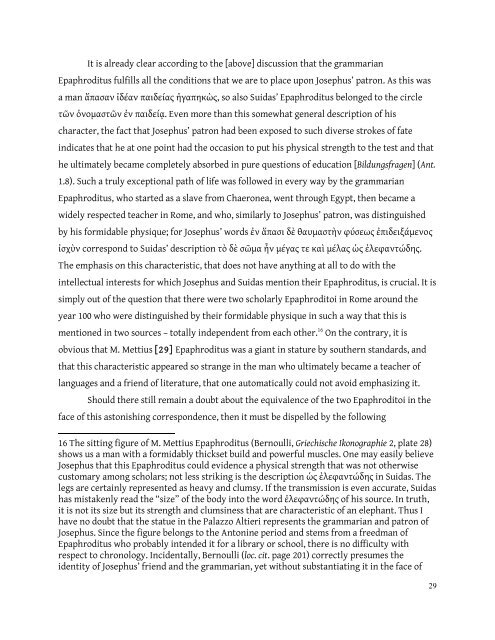The Jewish Historian Flavius Josephus: A Biographical Investigation
The Jewish Historian Flavius Josephus: A Biographical Investigation
The Jewish Historian Flavius Josephus: A Biographical Investigation
You also want an ePaper? Increase the reach of your titles
YUMPU automatically turns print PDFs into web optimized ePapers that Google loves.
It is already clear according to the [above] discussion that the grammarian<br />
Epaphroditus fulfills all the conditions that we are to place upon <strong>Josephus</strong>’ patron. As this was<br />
a man ἅπασαν ἰδέαν παιδείας ἠγαπηκὼς, so also Suidas’ Epaphroditus belonged to the circle<br />
τῶν ὀνομαστῶν ἐν παιδείᾳ. Even more than this somewhat general description of his<br />
character, the fact that <strong>Josephus</strong>’ patron had been exposed to such diverse strokes of fate<br />
indicates that he at one point had the occasion to put his physical strength to the test and that<br />
he ultimately became completely absorbed in pure questions of education [Bildungsfragen] (Ant.<br />
1.8). Such a truly exceptional path of life was followed in every way by the grammarian<br />
Epaphroditus, who started as a slave from Chaeronea, went through Egypt, then became a<br />
widely respected teacher in Rome, and who, similarly to <strong>Josephus</strong>’ patron, was distinguished<br />
by his formidable physique; for <strong>Josephus</strong>’ words ἐν ἅπασι δὲ θαυμαστὴν φύσεως ἐπιδειξάμενος<br />
ἰσχὺν correspond to Suidas’ description τὸ δὲ σῶμα ἦν μέγας τε καὶ μέλας ὡς ἐλεφαντώδης.<br />
<strong>The</strong> emphasis on this characteristic, that does not have anything at all to do with the<br />
intellectual interests for which <strong>Josephus</strong> and Suidas mention their Epaphroditus, is crucial. It is<br />
simply out of the question that there were two scholarly Epaphroditoi in Rome around the<br />
year 100 who were distinguished by their formidable physique in such a way that this is<br />
mentioned in two sources – totally independent from each other. 16 On the contrary, it is<br />
obvious that M. Mettius [29] Epaphroditus was a giant in stature by southern standards, and<br />
that this characteristic appeared so strange in the man who ultimately became a teacher of<br />
languages and a friend of literature, that one automatically could not avoid emphasizing it.<br />
Should there still remain a doubt about the equivalence of the two Epaphroditoi in the<br />
face of this astonishing correspondence, then it must be dispelled by the following<br />
16 <strong>The</strong> sitting figure of M. Mettius Epaphroditus (Bernoulli, Griechische Ikonographie 2, plate 28)<br />
shows us a man with a formidably thickset build and powerful muscles. One may easily believe<br />
<strong>Josephus</strong> that this Epaphroditus could evidence a physical strength that was not otherwise<br />
customary among scholars; not less striking is the description ὡς ἐλεφαντώδης in Suidas. <strong>The</strong><br />
legs are certainly represented as heavy and clumsy. If the transmission is even accurate, Suidas<br />
has mistakenly read the “size” of the body into the word ἐλεφαντώδης of his source. In truth,<br />
it is not its size but its strength and clumsiness that are characteristic of an elephant. Thus I<br />
have no doubt that the statue in the Palazzo Altieri represents the grammarian and patron of<br />
<strong>Josephus</strong>. Since the figure belongs to the Antonine period and stems from a freedman of<br />
Epaphroditus who probably intended it for a library or school, there is no difficulty with<br />
respect to chronology. Incidentally, Bernoulli (loc. cit. page 201) correctly presumes the<br />
identity of <strong>Josephus</strong>’ friend and the grammarian, yet without substantiating it in the face of<br />
29
















